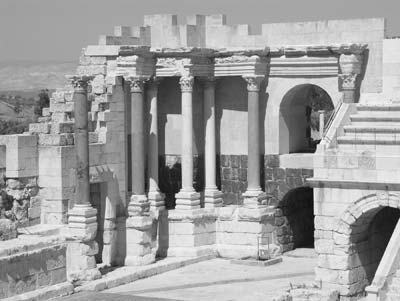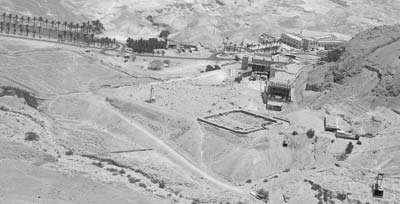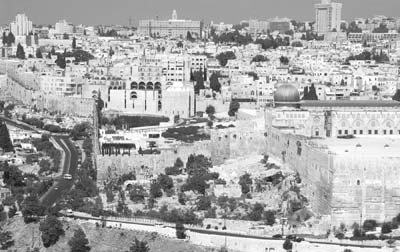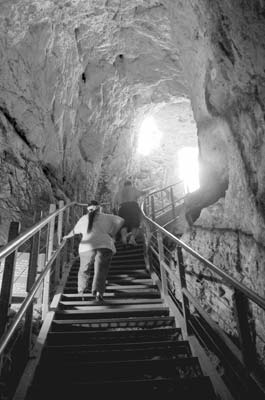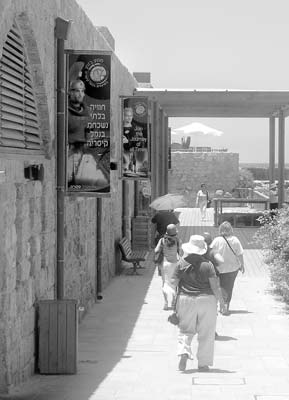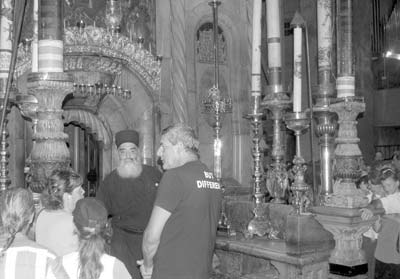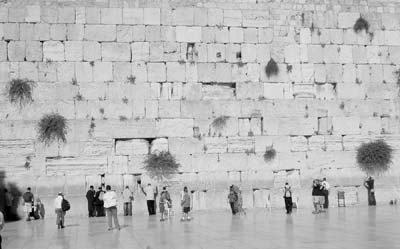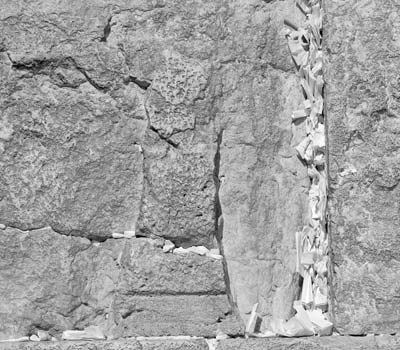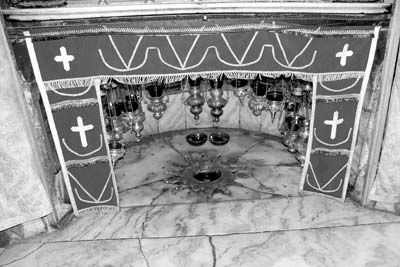Israel — Why visit? Where to go? Is it safe?
by Noel Canfield including text and photos from Roger Canfield, Contributing Editors
Visiting Israel was a childhood dream of mine, one inspired by films such as “Exodus” and “Ben Hur” and my reading the Bible and James Michener’s “The Source.” So I was thrilled to be invited aboard El Al’s inaugural nonstop flight from Los Angeles to Tel Aviv/Yafo (Jaffa) for a tour July 23-30, 2006.
A week before our departure, Hezbollah began firing rockets into northern Israel from Lebanon, wounding and killing Israelis, Arab and Jew alike. I did decide to go through with my trip, but I wondered what it would be like.
The flight
My flight was preceeded by a thorough search of my luggage. A gun-shaped bottle of sunscreen I had was of particular interest. El Al security personnel’s asking many questions and my going through numerous levels of electronic screening made me feel safe. Knowing that the pilots and cockpit crews all were ex-Israeli Air Force added to my feeling very secure.
El Al’s new nonstop flight leaves Los Angeles at 12:15 p.m. on Sundays, Tuesdays and Thursdays year-round, arriving in Tel Aviv/Yafo 13½ to 14 hours later. The return flight leaves Tel Aviv at 1:15 a.m., arriving at LAX at 5:45 a.m. — 14½ hours later. They are long flights but less grueling than dealing with long layovers.
Being an Israeli airline, El Al is kosher. That includes dinner. My salmon tartare with capers appetizer (served in business class) was outstanding. There were three enticing choices for the main course.
Before I knew it, we were eating breakfast over Western Europe. We landed on time at 12:45 p.m. at the new Ben Gurion Airport. At touchdown, all the passengers clapped to congratulate the crew for a job well done.
Getting settled
At the baggage carousel we met our guide, Alex Ziv from Consolidated Tour Operators (Tel Aviv; phone 972 3 5225253, www.ctotours.com). Over the course of our tour, I was amazed by his knowledge of history, religion, geology, archaeology, the nomenclature of local flora and fauna and international relations. He answered every question on any topic.
Alex also met the individual needs and interests of each group member. I was the slowpoke of our group, but Alex always slowed down to give me a chance to catch up. Also, he miraculously was able to drive the large van through the narrowest streets and park in the smallest spaces.
Our hotel for the first night was the Dan Tel Aviv. The first luxury hotel built in Tel Aviv, it was beautiful, nestled along the Mediterranean. The only negative was the registration and checkout process — very slow, lengthy procedures, as they were in all of our hotels.
A few historical sites
Our first wonderful Israeli breakfast was buffet style at the hotel. Then we greeted Alex and began with a quick bus tour of Tel Aviv/Jaffa. Afterward we drove north to Caesarea to see the ruins of a Roman theater, Herod’s castle (in the Mediterranean Sea) and a Crusader fortress.
Even more memorable was Tel Megiddo. Archaeologists have found 25 levels of continuous habitation there, including ruins from the 10th century B.C., the age of King Solomon.
Most spectacular was a wide shaft with stairs leading to a cistern fed by a tunnel drilled 215 feet through solid rock. The tunnel supplied the town with water from a spring outside the walls.
James Michener used the findings from Megiddo as the basis for Makor, the town in his novel “The Source.”
After a quick lunch, we went to Bet She’an National Park, an amazing excavation covering 3,500 years of history. The reconstruction of many buildings, baths and streets make this site exceptional.
The Dead Sea
Finally we rested our feet and sat in the cool van while we drove through the Jordan Valley. This was the infamous West Bank, thus we stopped at several checkpoints with armed soldiers.
Soon we were driving beside the Dead Sea in the Judean Desert, the most desolate place I’d ever seen, even though I’ve been to Afghanistan, Pakistan and Death Valley. On our left was the Dead Sea, the largest “natural spa” in the world. On our right was sterile rock rising to cliffs, with infrequent umbrella-like trees the only signs of life.
We came upon civilization in Ein Bokek, an area by the sea lined with modern resorts, including ours, the Crowne Plaza Dead Sea (800/980-6424, www.ichotelsgroup.com). The hotel had a very open, airy feeling and would be perfect for families visiting for a long time. Since both Europeans and Israelis frequent the Crowne Plaza, there was a phenomenal selection in the restaurant’s buffet.
The next day we visited Masada, an isolated rock plateau overlooking the Dead Sea where, in the first century A.D., the “last free Jews in Israel” chose to end their own lives rather than submit to Roman slavery.
After seeing a film and a huge model of the site, we went up to the fortress by tram. From there we saw ruins of Roman siege camps and the “snake path,” a winding, steep trail used for centuries to access Masada. The ruins included Herod the Great’s multilevel palace on the northern cliffs; the wall surrounding the plateau; buildings along the wall once used as homes, shops and factories; baths; a swimming pool, and a synagogue. I especially admired the huge cisterns dug out of rock which gathered every drop of water through an elaborate drainage system.
After our tour of Masada, we went to Kibbutz Ein Gedi, which produces skin-care products from the minerals of the Dead Sea, then had dinner at the Thai restaurant at our hotel. A good example of the international nature of the Israeli population was the restaurant’s having a Mexican chef and a Brazilian owner. The meal was excellent, the selections ranging from steak to Thai food.
Insightful sights
In the Carmel mountain region, we visited the Tishbi Winery (33 Hameyasdim St., Zichron Ya’acov 30900, Israel; phone 972-4-638-0434, www.tishbi.com), where its founder, Jonathan Tishbe, told his story of private enterprise — competing with state-subsidized wineries — and hosted a wine tasting.
His light, dry Chardonnay and full-bodied Cabernet are as good as any California wine. Today Israel has 200 private boutique wineries. — Roger Canfield
Leaving the Dead Sea, we drove through twisting mountain passes to Tel Arad. Excavations there revealed a lower and an upper city. Early Canaanites (3150-2200 B.C.) once inhabited the lower city. The upper city, “the hill of fortresses,” was first settled about 1200 B.C. Over the years, many fortresses were built, each on the ruins of the previous one. In the eighth century, Arad was destroyed; no one has lived there since.
Next we went to Be’er-Sheva (Beersheba) to see “The Market,” a traveling Bedouin outdoor bazaar. The Market goes to a different city every day of the week. Merchants sell everything from the daily requirements to exotic luxuries. It was particularly interesting to see Muslim women in various forms of modesty, from burqas to head scarves, while their daughters wore shorts.
The high point of the day was Mini Israel (phone 08 9130000, www.minisrael.co.il) in the town of Latrun. This Lilliputian display of 350 ancient and modern buildings, each having special importance to Israel, is built on a 1:25 scale. I was amazed by the detail of each model and fascinated by the tiny, live plants throughout the park — petite yews, oaks, firs, olives, etc. — all scaled to the size of the buildings. Mini Israel was truly enchanting, but it is impossible to appreciate fully in a couple of hours.
The park is open from 10 a.m. to 6 p.m. daily except Fridays, when it is open 10-2; entry cost around $15 per adult.
To Jerusalem!
The drive to Jerusalem was a climb through hills of rock and evergreens. Once there, we saw a unique city — hilly like San Francisco, segregated (Arab and Israeli) like America’s Old South, glowing like a birthday cake and refreshed, like a beach, by a constant breeze.
We spent our last nights in Israel at the Dan Panorama Jerusalem. The hotel had the ubiquitous buffet restaurant and a rooftop swimming pool with a stunning, panoramic view of Jerusalem. I especially liked the Shabbat elevator, designed to stop at every floor so no one has to push a button during Shabbat, the day of rest.
Our first stop the next day was the Israel Museum (www.imj.org.il), the home of lovely gardens and art shows. There we toured the Dome housing the Shrine of the Book, a display of replicas of ancient manuscripts, primarily the Dead Sea Scrolls.
Behind the Dome is a beautiful model of Old Jerusalem, built on a scale of 1:50. The model shows the city in A.D. 66, the year the Jews revolted against Roman rule. Walking around this model is not like walking through Mini Israel; it is a more stately experience than that at the amusement park.
Next came the most emotional part of our trip: Yad Vashem (972 2 6443400, www1.yadvashem.org), the Holocaust Martyrs’ & Heroes’ Remembrance Memorial dedicated to the six million Jews murdered in the Holocaust. It’s the world’s largest storehouse of Shoah (Hebrew for “Holocaust”) education, commemoration, research and documentation and is a vast complex of gardens, exhibits, archives, monuments and memorials.
Plaques in the Garden of the Righteous Among the Nations document names and countries of residence of non-Jews who risked their lives to help Jews during the Holocaust. Oscar Schindler is one of the 21,310 commemorated there.
The main exhibit is a vast, zigzagging maze located beneath a steeply triangular roof. Each “zig” is an alcove filled with photos, art, videos, oral testimony and artifacts (including gold teeth, letters, diaries, books, clothes, etc.) from victims of the Holocaust. It’s impossible to view each alcove thoroughly; it would take weeks to do so. More significantly, I believe most people could not cope with the emotional impact of actually inspecting each exhibit completely.
The final display at Yad Vashem is the Hall of Names (shem means “name” in Hebrew). The dome-like room has repositories around its wall which store more than two million “Pages of Testimony,” short biographies of each Holocaust victim. There is room for six million testimonies.
Among other sites we visited were the Benedictine Basilica of the Dormition, or Dormition Abbey, at Mount Zion, where the Virgin Mary “fell asleep” before she rose to Heaven (the Assumption of Mary), and one of the two most sacred sites for Jews, the Tomb of King David. (The Western Wall is the other site.) Unfortunately, we did not see the actual tomb, only the courtyard near it. Above the tomb is the Room of the Last Supper, where Jesus met with His disciples before the crucifixion. Amazingly, this religiously key site is a simple, sunny room.
Observation points
Friday night is the beginning of Shabbat, the Jewish day of rest which goes from Friday dusk to Saturday dusk. We were fortunate to have Shabbat dinner with El Al’s representative Aviva Lavi and her husband at the King David Hotel. Built in the 1920s, the King David is a magnificent example of the grandeur of British colonial architecture. The gardens and public rooms are grand and elegant in the Old European manner.
Not realizing how personal and diverse Judaism is, I was delighted to experience the prayers for Shabbat dinner and to watch others have their celebrations, ranging from quiet prayers to solo and group singing.
Saturday, the never-ending day, began with a drive to Mount Scopus for an awe-inspiring view of Jerusalem, then a quick drive to the Mount of Olives for another tremendous view of the Old City, the Dome of the Rock, a massive Jewish cemetery and the Garden of Gethsemane.
We drove down a steep Lombard Street type of road through the garden to the Church of the Agony, where we walked through an iron gate into an ancient olive grove. The trees were 2,000-plus years old.
The Basilica of the Agony, built on the site of the Garden of Gethsemane on top of two earlier churches in 1924, shields a section of rock where Jesus prayed in the garden on the night of his arrest. Six columns support 12 domes, inside of which are mosaics of the national emblems of donor groups. These mosaics explain why the church is also called the Church of All Nations. The front of the church has a huge mural portraying the events believed to have occurred at Gethsemane.
The Old City
We entered Jerusalem’s Old City through the western Jaffa Gate, which led us to the Armenian Quarter. Almost immediately we encountered the first of hundreds of tiny shops, their salesmen sitting on chairs outside and tempting us to buy their wares. They sold everything — except large appliances and cars — including boom boxes and food.
Since it was Shabbat, there was little activity and there were no shops open in the Jewish Quarter. Nevertheless, that’s where we saw excavations of the Cardo Maxima, the Roman road that went through the heart of Old Jerusalem.
Descending a long, steep staircase to a police “station,” where we were inspected, we continued to an enormous plaza, one side of which was the Western Wall. It is believed that this massive wall is part of the Second Temple, which was destroyed by the Roman emperor Titus in A.D. 68. The wall is a symbol of the Temple and the Old Kingdom of Israel.
The Western Wall has separate sections for men and women. Before reaching the wall, we saw bookcases where previous visitors had donated Torahs. Thankfully, chairs at the bottom of the wall allowed us to sit and pray comfortably. Every crack within human reach is crammed full of folded, rolled and crumpled fragments of paper filled with prayers.
Moving from the very spiritual to the very material, we found ourselves in the Muslim Quarter filled with more shops. Alex led us to an Arab restaurant where we each had an individual pizza. During lunch he pointed to a sign across the street which said, “Via Dolorosa.” I was eating pizza in Old Jerusalem next to the road where Jesus carried the cross!
The Via Dolorosa includes nine of the 14 Stations of the Cross commemorating Jesus’ route from His conviction by the Romans to His burial spot. We began at Station III, where Jesus first fell. The last five stations are in the Church of the Holy Sepulchre. The final station, where Jesus was buried, is the tomb donated by Joseph of Arimathea.
The basilica itself is a cluster of ornate chapels around the rock of Calvary, or Golgotha. This site has been sacred since Mary Magdalene and the disciples found His tomb empty. Today visitors wait quietly to enter, four at a time, to see the sepulchre (tomb).
Overall, the church was too ornate and dark, to the point of distracting me from what I was seeing: the site of the foundation of Christianity.
Little town of Bethlehem
Leaving Old Jerusalem, we had a short drive to Bethlehem. Alex and Aviva didn’t go into this walled Arab town since, as Israelis, they could have been kidnapped.
Just getting into Bethlehem was a project. We showed our passports to armed officials, went through a maze of fencing, crossed a vacant lot and went through a “gate” in the wall, where we met a Christian guide.
We were in Bethlehem! Sort of. Next we trudged down a steep road to a dead end where we found a van, a driver and another, female, Christian guide.
Sadly, the “little town of Bethlehem” disappointed me. Its buildings and people looked so run-down. There were few tourists because of the hostilities, and the town relies on tourism. Nevertheless, people were walking the narrow streets. Somehow our driver missed them, although I don’t know how — he drove like a maniac!
We arrived at the Church of the Nativity, the oldest church still in use in the Holy Land. It was built in A.D. 326 to commemorate the birthplace of Jesus. We literally crawled through a low entrance, which was made in the 16th century to prevent horses from entering the building. From this comical entrance, we entered a most holy site.
Steep steps led down to the Grotto (a cave believed to have been the “stable”) and the Altar of the Nativity. The marble floor beneath the altar has a 14-point silver star, which many believe marks the exact spot of Jesus’ birth. To one side is a small alcove with a stone ledge, the “manger” of the baby Jesus.
Nearby is a simple chapel honoring St. Joseph’s vision of the angel who warned him to take Mary and Jesus to Egypt to flee Herod. Another chapel honors the Holy Innocents, the children and infants Herod murdered seeking Jesus after His birth.
Our departure from Bethlehem was as hair-raising as our arrival. After a long walk through mazes and gates, we were thrilled to see Alex. I was stunned to find that my cohorts had been fearful in Bethlehem. I did not feel that way, despite rifles and razor wire.
Following this unbelievably long day, it was time to fly home. We spent our last hours in Israel in El Al’s marvelous 2-story lounge.
I flew home in coach and, yes, the seats were crowded, but the people were so friendly. It was like going to a huge family reunion, where you don’t really know most of the people. It was an experience I would have missed in business class.
Although busier than those in business class, the flight attendants provided service and food that were just as good.
Lasting impressions
Israel is an amazing merger of the ancient and the new, the secular and the religious. I didn’t get the feeling of antiquity that I have experienced in Europe, Pakistan and Afghanistan, probably because most construction is of local stone and plaster, so the ancient and new look alike. Then again, I’ve rarely felt as inspired spiritually as I was at Megiddo, Masada and the Church of the Nativity.
Although I spent five exhausting, foot-aching days walking through many of Israel’s unique sites, I realize how much I didn’t see. I’d love to go again. I would not, however, go in the summer; it’s just too hot! Aviva recommended fall or spring.
Because of the crisis in the Middle East, the Israel Ministry of Tourism has set up a 24-hour hotline (011-972-3520-7600).
For more information on many of the sites we visited in Israel, visit www.parks.org.il.
Planning a visit?
Noel’s husband, Roger, also visited Israel, in June ’06 as a guest of the Israel Ministry of Tourism (Yitzhak Rabin Way, 800 Second Ave., 16th Floor, New York, NY 10017; phone 212/499-5647, www.goisrael.com). Following are some of his observations.
• Why go there? For Jews, Christians, Muslims, Druze and Bahá’í, Israel is holy land. It is an archaeological feast bringing the history of Phoenicians, Greeks, Romans, Muslims, Crusaders and Ottoman Turks back to life. For a person like me with a Christian upbringing, walking a rocky path on a ridgeline to catch a sunrise over the Sea of Galilee, touching a stone marking the spot where the Cross of Jesus may have stood 2,000 years ago and entering the possible burial tomb of the Resurrected Christ, these were once-in-a-lifetime experiences.
• Is it safe? Since 1948, Israel has dealt successfully with security. Security procedures, fences, shelters and the Israeli Defense Force provide in-depth security. During my visit, there were people crowding tourist sites, hitchhiking everywhere and filling nightclubs and hotels.
Before planning your trip, check the State Department’s travel warnings (http://travel.state.gov). Avoid the Gaza Strip and the West Bank.
• Tours — The Ministry of Tourism licenses tour guides and sets a fee ($140 a day). Try specialty tours to fit your religious, recreational or other interests. Many tour contacts can be found at www.goisrael.com.
• Food — Kosher food is the exception today, unless specified. For budget meals, try delicious hummus, falafel and pita bread ($4-$5).
• Getting there — (Disclosure: Delta Airlines provided my flight.) The 5-hour domestic Delta flights from coast to coast had indifferent service and uncomfortable seats in business class. On the other hand, the 11½- and 12½-hour flights on Delta between Atlanta and Tel Aviv (Yafo) were great. The staff was attentive, courteous and patient and the seats were comfortable. — Roger Canfield
Noel Canfield was a guest of El Al (800/223-6700, www.elal.co.il) and Dan Hotels (800/223-7773-4, www.danhotels.com).


